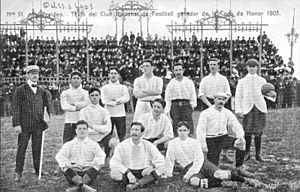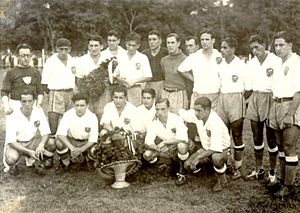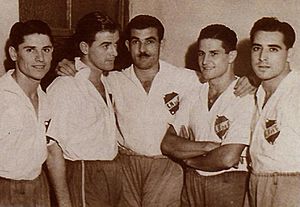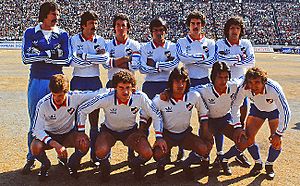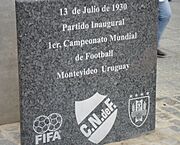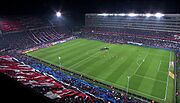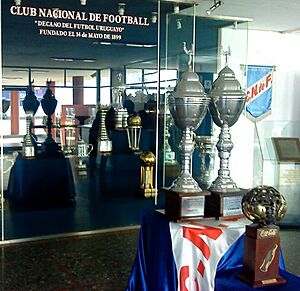Club Nacional de Football facts for kids
| Full name | Club Nacional de Football | |||
|---|---|---|---|---|
| Nickname(s) | Albos Bolso (The Pocket) Bolsilludos (The Pockets) Rey de Copas (King of Trophies) Tricolor |
|||
| Founded | 14 May 1899 | |||
| Ground | Gran Parque Central | |||
| Capacity | 38,000 | |||
| Chairman | Ricardo Vairo | |||
| Manager | Pablo Peirano | |||
| League | Primera División | |||
| 2024 | Primera División, 2nd of 16 | |||
|
||||
Club Nacional de Football is a professional sports club from Montevideo, Uruguay. It's one of the most famous football teams in Uruguay. The club plays in the Uruguayan Primera División, which is the top football league in Uruguay.
Nacional was started on May 14, 1899. It was formed when two clubs, Uruguay Athletic Club and Montevideo Football Club, joined together. Young students wanted to create a football club for local Uruguayan players. This made Nacional one of the first clubs in the Americas founded by people from the country itself.
Even though football is their main sport, Nacional also has teams for basketball, futsal, tennis, cycling, volleyball, and chess. In 2013, Nacional had over 60,000 members!
The club's colors are white, blue, and red. These colors are inspired by the flag of a national hero, José Gervasio Artigas. Nacional plays most of its home games at the Estadio Gran Parque Central. This stadium is special because it was one of the three places used for the very first 1930 FIFA World Cup in 1930. It even hosted one of the opening games between Belgium and the United States. Famous teams like Argentina and Brazil also played their first World Cup matches there.
Nacional is known as one of the most successful football clubs in the world. They have won the Primera División title 49 times, most recently in 2022. They have also won many other national cups. On the international stage, Nacional has won 9 titles recognized by FIFA and CONMEBOL. This includes three Copa Libertadores (in 1971, 1980, and 1988). Nacional is the second best team ever in the Copa Libertadores, based on points. They have also won all three Copa Intercontinental matches they played (in 1971, 1980, and 1988).
Nacional is the only Uruguayan team to win the Copa Interamericana (twice) and the Recopa Sudamericana. They won the first Recopa Sudamericana in 1989. The club has never been moved down to a lower league. They have a big rivalry with Peñarol, known as El Clásico Uruguayo. Nacional was named the best Uruguayan team from 2001 to 2010 by IFFHS.
Contents
Club History
How Nacional Started
Nacional was formed on May 14, 1899, by combining Montevideo Football Club and Uruguay Athletic Club. The club decided to use red, blue, and white in its flag, colors linked to Uruguay's national hero, José Gervasio Artigas. Their first uniform was mostly red and blue.
In 1900, Nacional joined with Club Defensa and its players. They started playing at the Estadio Gran Parque Central. At first, other clubs didn't want Nacional to join their league because they thought local clubs weren't good enough. But Nacional played so well in friendly matches that they were invited to join the Argentinean League. Because of this, the Uruguayan League had to let Nacional join in 1901. In 1902, Nacional won its first Uruguayan Primera División title. The red jersey was changed to a white one in 1902.
In September 1903, Nacional's players represented the entire Uruguay national football team. They beat Argentina 3–2. This was the first international match between national teams in Uruguayan football history. In 1905, Nacional won its first international title, the Copa de Honor Cousenier.
In 1911, the club decided to allow players from all backgrounds to join. This was a big change that helped players like Abdón Porte become club legends.
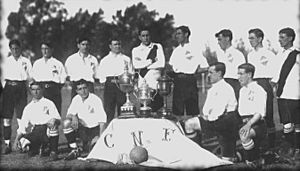
Around 1900, Nacional's players developed a new style of play. It was less about physical strength and more about clever passes and quick dribbles. They focused on fast, short passes and quick sprints.
After winning the 1912 championship, Nacional won the "Triple Crown" in 1915. This included three major tournaments: Primera División, Tie Cup, and Copa de Honor Cousenier. Nacional was also the first club to win three championships in a row, winning in 1916 and 1917. They continued to win league titles in 1919, 1920, 1922, 1923, and 1924.
Internationally, Nacional won three Copa Aldao (1916, 1919, 1920), three Copa de Honor Cousenier in a row (1915, 1916, 1917), and two Tie Cups (1913, 1915).
International Tours and Success
Nacional's success helped Uruguay achieve international football fame. In 1924, many Nacional players were part of the Uruguayan team that won the Summer Olympics in Paris. Nacional also had many players on the Uruguayan teams that won the Olympics in 1928 and the World Cup in 1930. Nacional is the only Uruguayan club that has had players on every Uruguayan national team that won international tournaments.
In 1925, because of Uruguay's success at the 1924 Olympics, Nacional was invited to tour Europe. They played 38 matches over six months against national teams and professional clubs from 9 European countries. Nacional won 26 matches, tied 7, and lost only 5. They scored 130 goals and let in 30. About 800,000 tickets were sold for these games in France, Italy, Spain, the Netherlands, Switzerland, Austria, and Portugal. This was considered the biggest tour in football history.
In 1927, Nacional went on a North America tour and had similar great results. They won 16 games, tied 2, and lost only 1.
The "White Machine" Team: 1932–1943
In 1932, football became professional in Uruguay. Nacional formed a team nicknamed La Máquina Blanca (The White Machine). This team scored 28 goals in their first four games of the 1932 season. Nacional won its 12th first division title in 1933 and again in 1934. The 1933 championship was the longest ever, ending in November 1934 after many final games against Peñarol. Nacional won the last game 3–1, with three goals by Héctor Castro.
In 1938, Argentine player Atilio García joined the club. That same year, Nacional won the Torneo Internacional Nocturno Rioplatense, an international friendly championship. From 1939 to 1943, coached by former player Héctor Castro, Nacional won the Quinquenio de Oro (five championships in a row). A highlight was their 5–1 victory over Peñarol, with four goals by Atilio García. In the 1941 season, Nacional won all 20 games they played. During these five years, they played 96 league games, winning 77, tying 9, and losing only 10. They scored 318 goals and allowed 108.
Nacional was much stronger than Peñarol during this time.
- Between 1938 and 1943, there were 23 matches between the rivals. Nacional won 18 of them, while Peñarol won only 4.
- On December 14, 1941, Nacional achieved its biggest win ever against Peñarol, defeating them 6–0.
- On November 23, 1943, Nacional won its tenth league match in a row against Peñarol.
Important players from this period include Atilio García (Nacional's all-time top scorer with 465 goals), Aníbal Paz, Schubert Gambetta, Luis Ernesto Castro, Aníbal Ciocca, Eugenio Pato Galvalisi, Roberto Porta, and Bibiano Zapirain.
International Triumphs
Nacional's international fame grew from tournaments played in the Río de la Plata region in the early 1900s. These were the most important international tournaments in America before the Copa Libertadores began. Nacional developed rivalries with teams like Peñarol and famous Argentine teams such as Boca, River Plate, and Racing.
Nacional first played in the Copa Libertadores in 1962. They reached the finals in 1964 and 1967, but lost both times. In the 1969 Libertadores, Nacional lost their third final against Estudiantes de La Plata.
In 1971, coached by Washington Etchamendi, Nacional finally won its first Copa Libertadores. They beat Estudiantes de La Plata in Peru. That year, Nacional also won its first World Club title, the 1971 Intercontinental Cup. They played against Panathinaikos from Greece. The next year, Nacional won its first Copa Interamericana, defeating Cruz Azul from Mexico.
During this time, Nacional also won four Uruguayan Championships in a row (1969, 1970, 1971, and 1972). They also had a long unbeaten streak against their rivals Peñarol, lasting 16 games from 1971 to 1974.
Nacional won the 1980 Copa Libertadores again, beating Internacional from Brazil in the finals. After becoming South American champions, Nacional won the Intercontinental Cup for the second time. They defeated European champions Nottingham Forest from England 1–0. That year, Nacional also won the Uruguayan championship.
Nacional won its third Copa Libertadores in 1988. They beat Argentine team Newell's Old Boys 3–0. That same year, Nacional won its third Intercontinental Cup in a thrilling final against Dutch team PSV Eindhoven. Nacional won in a penalty shootout after the game ended 2–2. The next year, Nacional won its second Copa Interamericana and the Recopa Sudamericana.
Recent Achievements
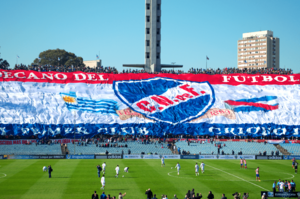
In the 1990s, the club faced some financial challenges and had fewer sports victories. However, they won the 1992 Championship. In 1998, Nacional won the 1998 Campeonato Uruguayo by winning both the "Apertura" and "Clausura" tournaments. This was the first time a club achieved this since the system started in 1994.
Nacional then dominated the national league for three years in a row (2000, 2001, and 2002).
In 2005, Nacional decided to improve its stadium, the Estadio Gran Parque Central. The team now plays most of its home games there instead of the national stadium, Estadio Centenario.
Nacional has been the most successful team since the start of the 21st century. They won championships in 2005, 2005–06, 2008–09, 2010–11, 2011–12, 2014–15, 2016, 2019, 2020, and 2022.
In 2018, Nacional played in the 2018 Copa Libertadores for the 45th time. This was their 22nd time in a row, setting a new record for the cup.
Team Look and Home Ground
Team Colors and Badge
Nacional's badge has a shield with a white stripe and the letters "C.N de F." on it. The badge's design was inspired by the Artigas flag.
The first home uniform, used from 1899 to 1902, had a red shirt with blue sleeves and collar. In 1902, the team changed its jersey to avoid looking too similar to another club, Albion F.C. The new uniform was a white shirt with a front pocket, blue pants, and a red sash. The pocket on the shirt led to the nickname "Los Bolsos," which means "The Pockets" in Spanish. The "C. N de F." badge was added above the pocket.
In 1995, the club started using three different uniforms. The red shirt became the third kit, and a new blue shirt with a red stripe became the official away kit. Since 2002, the red kit has been the official away kit, and the blue kit is the third option.
Nacional's Stadium
Nacional plays most of its home games at its own stadium, the Estadio Gran Parque Central in Montevideo. It can hold 38,000 people, and it's still growing to reach 40,089. The stadium was first built in 1900.
It's located in a historic area where a revolutionary leader, José Gervasio Artigas, was named "Chief of the Orientals" in 1811. For many years, Nacional often played at the national stadium, Estadio Centenario, sharing it with Peñarol. But in 2005, Nacional decided to return to the Gran Parque Central. Since then, the stadium has been renovated, allowing Nacional to host most of its home games there, including many international matches. However, very important matches and rival games are still played at the Centenario.
The four stands in the stadium are named after important figures:
- The main stand, with press and VIP boxes, is called José María Delgado, after a key club president.
- The largest stand is the Atilio García, named after Nacional's all-time top scorer.
- The Abdón Porte stand is named after a player who was a big symbol for Nacional. This is where the organized fan group sits.
- The Héctor Scarone stand is named after another famous striker, nicknamed el Mago (the Wizard).
The stadium is still being improved, with new sections being built to connect the stands and add more seating.
Nacional Supporters
The First "Hincha"
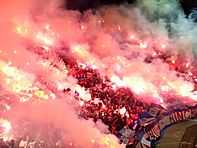 |
 |
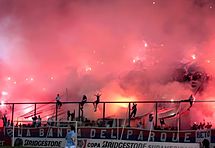 |
 |
The Spanish word for football fans is "hincha." This word was actually created by Nacional fans! Prudencio Miguel Reyes, an employee of Nacional in the early 1900s, was famous for cheering loudly for the team. Other fans started calling him by one of his jobs: pumping air into the footballs (in Spanish, "hinchar" means to pump). Soon, Reyes became known as the "hincha" of Nacional. This is how a word used by Spanish speakers worldwide came to be.
"The Biggest Flag in the World"
In June 2013, Nacional supporters showed off what they called the biggest flag in the world. They displayed this huge flag during a match against Deportivo Toluca in the 2013 Copa Libertadores. The flag cost US$50,000, which was collected by the fans themselves.
The flag was 600 meters long and 50 meters high. It entered the Guinness World Records as "the biggest flag ever seen in a football match." The flag weighed 5,000 kg, and 400 people were needed to move it.
Team Nicknames
Nacional has several nicknames:
- "Tricolores" (meaning "three colors") because of their white, blue, and red colors.
- "Albos" (meaning "whites") referring to their white jersey.
- "Bolsilludos," later shortened to "Bolsos" (meaning "pockets"). This nickname came from their old jersey that had a pocket on the chest.
- "La blanca" (another reference to the white jersey) is also used sometimes.
Current Players
|
|
Players on Loan
|
Player Records
- Most games played:
 Emilio Álvarez (511 matches)
Emilio Álvarez (511 matches) - Most years with the club:
 Héctor Scarone (21 years, from 1917 to 1939)
Héctor Scarone (21 years, from 1917 to 1939) - All-time top scorer:
 Atilio García (465 goals)
Atilio García (465 goals) - Longest time without letting in a goal:
 Sergio Rochet (1064 minutes)
Sergio Rochet (1064 minutes)
World Champion Players
In 1924, Nacional had the most players on Uruguay's team that won the Olympic gold medal in football. The same happened with Uruguay's teams in 1928 and 1930, which were Olympic and World champions. Nacional is the only Uruguayan club that has had players on every Uruguayan national team that won international tournaments.
Here are the Nacional players who were part of Uruguay's Olympic and World Cup winning teams:
|
1924 Olympic Champions
|
1928 Olympic Champions
|
|
|
Notable Coaches
|
|
Club Trophies
- Keys
- Record
- (s) Shared record
| Type | Competition | Titles | Winning years |
|---|---|---|---|
| National League | Primera División | 49 | 1902, 1903, 1912, 1915, 1916, 1917, 1919, 1920, 1922, 1923, 1924, 1933, 1934, 1939, 1940, 1941, 1942, 1943, 1946, 1947, 1950, 1952, 1955, 1956, 1957, 1963, 1966, 1969, 1970, 1971, 1972, 1977, 1980, 1983, 1992, 1998, 2000, 2001, 2002, 2005, 2005–06, 2008–09, 2010–11, 2011–12, 2014–15, 2016, 2019, 2020, 2022 |
| Half-year / Short League Tournaments |
Torneo Apertura | 12 |
1997, 1998, 1999, 2000, 2002, 2003, 2004, 2008, 2009, 2011, 2014, 2018
|
| Torneo Clausura | 8 |
1995, 1996, 1998, 2001, 2006, 2011, 2019, 2022
|
|
| Torneo Intermedio | 5 |
2017, 2019, 2020, 2022, 2024
|
|
| National Cups | Supercopa Uruguaya | 3(s) |
2019, 2021, 2025
|
| Torneo de Honor | 15 |
1935, 1938, 1939, 1940, 1941, 1942, 1943, 1946, 1948, 1955, 1957, 1958, 1961, 1962, 1963
|
|
| Torneo Competencia | 10 |
1934, 1942, 1945, 1948, 1952, 1958, 1959, 1961, 1962, 1963, 1989
|
|
| Liguilla Pre-Libertadores | 8 |
1982, 1990, 1992, 1993, 1996, 1999, 2007, 2008
|
|
| Copa Competencia | 7 |
1912, 1913, 1914, 1915, 1919, 1921, 1923
|
|
| Copa de Honor | 7 |
1905, 1906, 1913, 1914, 1915, 1916, 1917
|
|
| Torneo Cuadrangular | 7 |
1952, 1954, 1956, 1958, 1961, 1964, 1967
|
|
| Liga Mayor | 3 |
1975, 1976, 1977
|
|
| Copa León Peyrou | 3 |
1920, 1921, 1922
|
|
| Campeonato Nacional General Artigas | 2 |
1961, 1962
|
|
| Campeonato Ingeniero José Serrato | 1 |
1928
|
|
| Copa Albion de Caridad | 1 |
1919
|
|
| Torneo Fermín Garicoits | 1 |
1965
|
|
| Torneo Ciudad de Montevideo | 1 |
1973
|
|
| Torneo Campeones Olímpicos | 1 |
1974
|
|
| Campeonato Estadio Centenario | 1 |
1983
|
|
| International Cups | Intercontinental Cup | 3(s) |
1971, 1980, 1988
|
| Copa Libertadores | 3 |
1971, 1980, 1988
|
|
| Copa Interamericana | 2 |
1971, 1988
|
|
| Recopa Sudamericana | 1 |
1989
|
|
| Copa Aldao | 3 |
1916, 1919, 1920
|
|
| Copa de Honor Cousenier | 4 |
1905, 1915, 1916, 1917
|
|
| Tie Cup | 2 |
1913, 1915
|
|
| Copa de Confraternidad Escobar-Gerona | 1 |
1945
|
International Friendly Tournaments
| Type | Competition | Titles | Winning years |
|---|---|---|---|
| International (Cup) |
Copa Ciudad de Montevideo | 5 | 1953, 1969, 1970, 1978, 1984 |
| Torneo Internacional Nocturno Rioplatense | 1 | 1938 |
Youth Tournaments
| Type | Competition | Titles | Winning years |
|---|---|---|---|
| International (Cup) |
U-20 Copa Libertadores | 1 | 2018 |
| Copa Santiago de Futebol Juvenil | 2 | 1989, 1994 |
Other Sports at Nacional
Basketball
Nacional has a basketball team that plays in tournaments organized by the Uruguayan Basketball Federation (FUBB) since 1932. The club won championships in 1935 and 1937. Today, Nacional plays in the Liga Uruguaya de Basketball, which is Uruguay's top basketball league.
- Campeonato Federal (2): 1935, 1937.
- Liguilla (2): 1982, 1983.
Cycling
Nacional also has a cycling team that competes in championships organized by the Uruguayan Cycling Federation. The club has won major competitions like the Vuelta Ciclista del Uruguay and Rutas de América multiple times, both individually and as teams. A famous cyclist from Nacional is Milton Wynants, who won a silver medal for Uruguay at the 2000 Summer Olympics.
Vuelta Ciclista del Uruguay (9)
- Teams (5): 1960, 1968, 1994, 1999, 2000
- Individual (3)
* Leandro Noli: 1939 * Jorge Correa: 1968 * Milton Wynants: 1996 Rutas de América (6)
- Teams (5): 1993, 1994, 1995, 2000, 2001.
- General Individual (1)
* Gustavo Figueredo: 2000 Mil Millas Orientales (1)
- General Individual (1)
* Tomás Correa: 1960 Vuelta Ciclista del Paraguay (2)
- Teams (1): 1998
- Individual (1)
* Gustavo Figueredo: 1998
Tennis
Nacional has many tennis courts at Parque Central, behind the Abdón Porte stand. These courts host various stages of tournaments in Uruguay. In 2005, the club was honored to host several games played by Uruguay in the Davis Cup.
Volleyball
Nacional has its volleyball court at Parque Central. The club plays its home games there for championships organized by the Uruguayan Volleyball Federation in all age groups.
Men's Volleyball (9)
- Campeonato Federal (1): 1954.
- Super Liga Uruguaya de Voleibol (3): 2008, 2009, 2010.
- Campeonato Uruguayo Livosur (1): 2010.
- Torneo Apertura Livosur (2): 2009, 2010.
- Torneo Clausura Livosur (2): 2006, 2008.
Women's Volleyball (4)
- Campeonato Federal (3): 1955, 1960, 1961.
- Torneo Abierto ciudad de Minas: 2011
Women's Football
Nacional has been part of the women's football tournaments organized by the Uruguayan Football Association since 1996. They won the Uruguayan Championship in 1997, 2000, 2010, and 2011–2012. Nacional has also played in various South American championships.
Futsal
Nacional's futsal team plays in championships organized by the Uruguayan Football Association's Futsal Commission. The club has won the Uruguayan league title many times and is currently the Uruguayan champion. Internationally, Nacional's best achievement is finishing second in the South American Futsal Cup Copa Libertadores de América de Futsal in 2003.
Official National Tournaments (23)
- Campeonato Uruguayo (7): 1998, 2000, 2002, 2003, 2005, 2008, 2009.
- Campeonato Metropolitano (5): 2002, 2004, 2005, 2007, 2009.
- Copa de Honor (Liguilla Pre Libertadores) (3): 2006, 2010, 2011.
- Campeonato Apertura (5): 1998, 2000, 2005, 2008, 2009.
- Campeonato Clausura (3): 1998, 2002, 2009.
Official International Tournaments (1)
- Winner of the South Zone of the Copa Libertadores de Futsal: 2003.
See also
 In Spanish: Club Nacional de Football para niños
In Spanish: Club Nacional de Football para niños
- Club Nacional de Football (women)
- Club Nacional de Football (basketball)
- List of world champion football clubs


